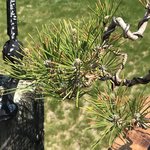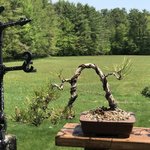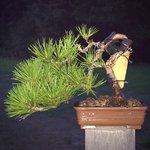I’m hoping to gather a little advice/help at the conclusion of this first post so keep that in mind. This tree was acquired as a haggle with a local nursery near the end of last season. It was potted in a large, fairly nice, blue pot as a seedling apparently with 3 other trees. By the time I acquired it one had either died or otherwise been removed. The root mass was rock hard and there was very little water penetration from traditional watering so I was soaking/submerging the pot to water the trees. There was almost no growth and I was told the tree had not pushed candles in at least a couple years
I picked up a bristlecone at the same time but that’s another story. I made the decision to de-pot, break the individual plants apart and re-pot into nursery cans. One I gave to a friend, one went into the ground and I kept the last one in a nursery can to work on. I haven’t checked up on the one I gave away, the one that went into the ground was killed almost instantly by a hard freeze and I caught the other one in the nursery can mid freeze and moved it to a deep set window box in the warehouse where I work. Believe it or not this saved the tree. The warehouse is situated over the water on a pier in Portland, Maine that has open drains in the floor (it’s a fish processing area with lots of outside air exchange) so the temps stayed around 45 to 55 but the conditions were otherwise moist and “coastal”. Over the winter I slowly worked a pretty severe bend into the otherwise straight and boring trunk and at the end of April I pruned the tree of unneeded limbs and styled the remaining branches into a semi-cascade.
One I gave to a friend, one went into the ground and I kept the last one in a nursery can to work on. I haven’t checked up on the one I gave away, the one that went into the ground was killed almost instantly by a hard freeze and I caught the other one in the nursery can mid freeze and moved it to a deep set window box in the warehouse where I work. Believe it or not this saved the tree. The warehouse is situated over the water on a pier in Portland, Maine that has open drains in the floor (it’s a fish processing area with lots of outside air exchange) so the temps stayed around 45 to 55 but the conditions were otherwise moist and “coastal”. Over the winter I slowly worked a pretty severe bend into the otherwise straight and boring trunk and at the end of April I pruned the tree of unneeded limbs and styled the remaining branches into a semi-cascade. The tree was damaged by the freeze last fall, many needles suffered so I was not sure how it would pull through what I had done but now it is pushing candles and is showing some positive signs of vigor.
The tree was damaged by the freeze last fall, many needles suffered so I was not sure how it would pull through what I had done but now it is pushing candles and is showing some positive signs of vigor.
I’m now left with the question as to how to handle the candles. Should I decandle everything in late June as normal or is there another way to handle a tree where the vigor is somewhat questionable. This is my first Japanese Black Pine so any input is welcome. Thanks!!!


I picked up a bristlecone at the same time but that’s another story. I made the decision to de-pot, break the individual plants apart and re-pot into nursery cans.
 One I gave to a friend, one went into the ground and I kept the last one in a nursery can to work on. I haven’t checked up on the one I gave away, the one that went into the ground was killed almost instantly by a hard freeze and I caught the other one in the nursery can mid freeze and moved it to a deep set window box in the warehouse where I work. Believe it or not this saved the tree. The warehouse is situated over the water on a pier in Portland, Maine that has open drains in the floor (it’s a fish processing area with lots of outside air exchange) so the temps stayed around 45 to 55 but the conditions were otherwise moist and “coastal”. Over the winter I slowly worked a pretty severe bend into the otherwise straight and boring trunk and at the end of April I pruned the tree of unneeded limbs and styled the remaining branches into a semi-cascade.
One I gave to a friend, one went into the ground and I kept the last one in a nursery can to work on. I haven’t checked up on the one I gave away, the one that went into the ground was killed almost instantly by a hard freeze and I caught the other one in the nursery can mid freeze and moved it to a deep set window box in the warehouse where I work. Believe it or not this saved the tree. The warehouse is situated over the water on a pier in Portland, Maine that has open drains in the floor (it’s a fish processing area with lots of outside air exchange) so the temps stayed around 45 to 55 but the conditions were otherwise moist and “coastal”. Over the winter I slowly worked a pretty severe bend into the otherwise straight and boring trunk and at the end of April I pruned the tree of unneeded limbs and styled the remaining branches into a semi-cascade. The tree was damaged by the freeze last fall, many needles suffered so I was not sure how it would pull through what I had done but now it is pushing candles and is showing some positive signs of vigor.
The tree was damaged by the freeze last fall, many needles suffered so I was not sure how it would pull through what I had done but now it is pushing candles and is showing some positive signs of vigor.
I’m now left with the question as to how to handle the candles. Should I decandle everything in late June as normal or is there another way to handle a tree where the vigor is somewhat questionable. This is my first Japanese Black Pine so any input is welcome. Thanks!!!

Last edited:


